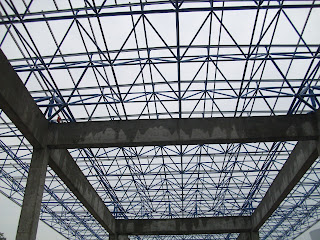Steel Space Structures in Power Plants — Supporting Heavy Loads and Complex Systems
In modern power generation facilities — from thermal and hydro plants to large-scale renewable energy complexes — the demand for robust yet adaptable structural systems is increasing. Steel space structures offer engineers and builders the flexibility, strength, and efficiency needed to support complex mechanical systems and heavy loads while optimizing material use and spatial performance.
1. Functional Requirements of Power Plant Structures
Power plants are not ordinary industrial buildings. They must accommodate turbines, boilers, cooling systems, and control equipment, all of which require high vertical clearance and precise load distribution. The roof and supporting system need to:
-
Handle extremely high static and dynamic loads from heavy machinery and cranes.
-
Maintain large column-free spaces for equipment movement and installation.
-
Allow integration of ducts, pipes, and cable trays without structural interference.
-
Ensure durability under vibration, heat, and sometimes corrosive environments.
2. Advantages of Using Steel Space Structures
Steel space structures — including double-layer grids, latticed domes, and pipe trusses — are ideal for meeting these needs:
-
Exceptional Load Distribution: Their three-dimensional behavior allows even transfer of heavy mechanical and environmental loads.
-
Modular Assembly: Prefabricated nodes and members enable rapid on-site installation, minimizing plant downtime.
-
Long Span Capability: Roofs exceeding 100 meters can be achieved without intermediate supports, perfect for turbine halls or boiler houses.
-
Integration with MEP Systems: The open grid form allows engineers to pass large conduits through the structure.
-
Adaptability: Space frames can be designed for expansion or retrofitting as plants upgrade capacity.
3. Applications in Different Power Plant Types
-
Thermal Power Stations: Space structures cover turbine halls and coal handling areas, providing resistance to high heat and dust.
-
Hydroelectric Plants: Used in dam-top control rooms and maintenance facilities where span efficiency and seismic resistance are key.
-
Solar Power Farms: Space trusses support photovoltaic panels with optimized inclination angles and lightweight yet durable framing.
-
Nuclear Facilities: Space structures are used for secondary containment buildings and service halls, where redundancy and stiffness are critical.
4. Material and Design Considerations
-
Corrosion Resistance: Galvanized or painted high-strength steel (e.g., Q355, ASTM A500) ensures long service life.
-
Seismic Design: The inherent rigidity and multi-directional load paths enhance earthquake resilience.
-
Thermal Expansion: Expansion joints and sliding connections are crucial for high-temperature environments.
-
Maintenance Access: Walkways and inspection platforms can be integrated within the space frame geometry.
5. Representative Project Example
The Tuoketuo Thermal Power Plant in China — one of the largest coal-fired plants in the world — employs a massive steel space frame roof over its turbine hall, spanning 120 meters. Its modular installation reduced construction time and improved safety during assembly.
6. Future Outlook
As the energy industry moves toward hybrid and renewable systems, space structures will continue to play a vital role — not just for covering turbine halls but also for supporting solar fields, hydrogen storage facilities, and battery warehouses. The balance between strength, efficiency, and adaptability makes steel space structures a backbone of modern energy infrastructure.




评论
发表评论